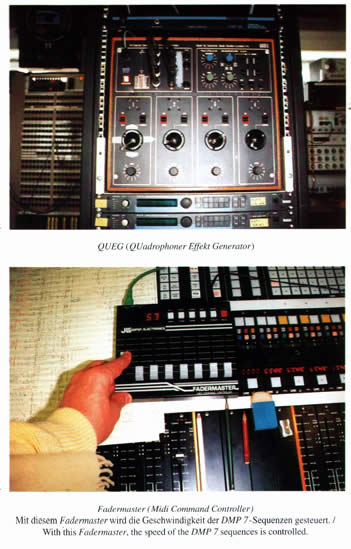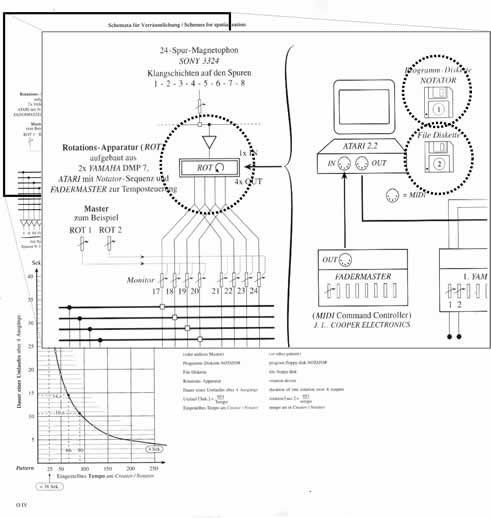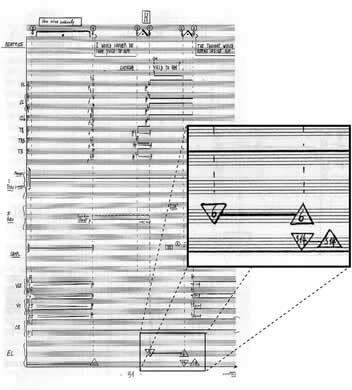Sustainable Live Electroacoustic Music
This paper was first given at the Sound and Music Computing 2005 conference (XV CIM, 24–26 November 2005, Salerno, Italy).
Real-time/performed electroacoustic music (also known as live electroacoustic music) is currently facing a serious sustainability problem: while its production is indeed considered very recent from the music history point of view, several technological generations and revolutions have gone by in the meantime. Thus, most of these works can hardly be performed because the technologies used have gone lost since a long time and no long-standing notational precaution was taken. This paper presents some typical case studies and examples and introduces some techniques that might lead to a partial — when not completely adequate — solution to the sustainability problem.
1.
Digital preservation and archival of cultural assets is now a widely-studied and active research problem everywhere (cf. Marcum and Friedlander, Porck and Teygeler, Rotherberg, Nono). The music domain is no exception to this rule, ranging from the preservation of score manuscripts to that of antique musical instruments, old recordings (1), electroacoustic music on tape (cf. Canazza et al, 2001 and 2002), etc. In general, from these studies it appears that digital preservation of dense documents (2) coupled with symbolic representation of linguistic elements (where available) would be sufficient to preserve most artistic works in the music domain.
There is a specific music field, however, which presents many more problems in the preservation of its works: live electroacoustic music. Most, if not all, live electroacoustic works are endangered today because their sustainability in time is extremely low — there is an urgent need for research and solutions to face an otherwise inevitable loss of many masterpieces of the past century. Furthermore, if the sustainability problems of live electroacoustic music are not tackled, current and future works may well face the same fate of their predecessors.
2. Problems
Live electroacoustic music is indeed a “performance-intensive” art form which may somehow relate to other similar musical formats: jazz, popular music or “performer-centered” interpretations are the first that come to mind. These may include, for example, the jazz standards performed by an extraordinary artist, rock-band concerts and records, sublime interpretation of classical works by legendary singers or players, etc. In general, preserving these formats implies preserving the recorded documents that contain them. While that is not the performance per se, its high-quality reproduction is deemed acceptable for memory preservation.
Live electroacoustic music is different in that we seek to preserve not only a single, memorable performance but rather the ability to to perform, study and re-interpret the same work over and over again, with different performances proposing different interpretations. A recorded document of the first (or indeed, of any) performance of a live electroacoustic music work is instead completely insufficient and inadequate to the re-creation of the work itself.
Of course, this would call for a score capable of providing the necessary performance indications to the complete re-construction of the piece. Symbolic notation, abstracted from practical implementation and the underlying technology, is extremely important here. In this case, notation should be both descriptive and prescriptive to some extent (it should define which result is sought and how to get it — always in device-independent terms). However, live electroacoustic music currently possesses notational conventions and practices that can be compared at best to tablatures of the Middle Ages. This is due to several factors, the most important being the availability of recording technology which has been considered, for years, as the proper way to preserve the details concerning the electroacoustic performance. This, in connection with
- use of end-user configuration patches using proprietary software and hardware technologies (cf. Sec. 4.1);
- use of binary and especially proprietary file formats, has lead to huge losses in performance information of many live electroacoustic music works. It is now time to think about the sustainability of these past, present and future works.
3. Possible Solutions
Scores are essential to speculative (i.e.: non-commercial, non-programmatic) music to preserve two fundamental musical functions, namely reproduction and interpretation of the works; most live electroacoustic music is no exception to this requirement. Full-blown audio-video recordings are not appropriate, because:
- recordings do not convey any of the necessary instructions (descriptive and prescriptive) that are required to re-interpret the work, and
- they give a “reference” interpretation to mimic, thus seriously jeopardizing the possibility of new interpretation.
Furthermore, the score representation must resist time degradation and technological revolutions, so it must rely on lower level standard common denominators (such as paper, widely diffused sound file formats, standard metric units, etc.).
These considerations have lead to the following solutions that should be adopted to for any sustainabilityaware live electroacoustic score — it should be augmented with
- a multimedia glossary covering all live electroacoustic processing found in the work; every item should have:
- an algorithmic description
- an impulse response
- an audio example
These items should be provided in an ASCII-based standardized format (such as XML).
- a computer-assisted notation system based on the orchestra/score paradigm (i.e. a description / prescription of how sounds are built, and a description/ prescription of when they should be built in time).
We maintain that a multimedia glossary indeed provides completely different information than a full-blown recording of a passage or an entire piece. A glossary such as the one devised above allows performers to verify if single elements are in place while leaving most of the interpretation (e.g. quantities, speeds, etc.) to them. Furthermore, while the impulse response of a processing system possesses the abstraction qualities that we seek, it would probably be too hard, in most cases, to trace back the (usually complex) system producing it. The impulse response should then be complemented by an accurate algorithmic description of each electroacoustic process and the impulse response (or its transfer function) should rather serve as a checking tool (much like the test-tones were used on electroacoustic tapes in the analog era).
The orchestra/score paradigm is still relevant because it allows for good separation of system data from performance data, a lowering of the complexity barrier during performance, and seamless integration with traditional instrument performance.
True, the orchestra/score has a number of serious drawbacks (cf. for example Lazzarini), the most important being that of promoting a mindset which separates processes from events. This separation is often very weak, if not utterly nonexistent, in electroacoustic music as well as in much contemporary music thinking. However, the lack of a distinctly better model and the advantages enumerated above suggest that this paradigm can still find its use in live electroacoustic music. The adoption of sustainability-aware score models may be considerably facilitated by computer-assisted notation software applications that should be devised to:
- automatically pick up internal data of electronic devices such as mixers, effects, DSPs, etc. and convert it to a common format (such as XML) using ASCII, standard metric units, etc.;
- provide objective representations such as time-local impulse response plots;
- provide assistance to the composer in devising the performance notation related to the above elements.
Along the same lines, live electroacoustic music transcription and documentation should constitute an integral part of the creation of a work (just as writing a score is essential to most contemporary music) and it could/should become an editorial profession just as professional music copying is.
These elements should provide long-standing sustainability to live electroacoustic music works.
4. Case Studies
Live electroacoustic music is quite an abundant field which provides many examples with much diversity of contexts and settings. Unfortunately, most of these examples are problematic: the way the scores are realized do not allow the performance of the score any longer or will not allow it in the very short future (we must always think that in music 50 years is a very short future). Of course, a problematic example of live electroacoustic music scoring has nothing to do with the quality of the music itself. However, a problematic example of scoring of a great piece will not allow its performance any longer and that makes it even more problematic — if at all possible. Luckily, a few positive examples exist. No example is really perfect and many problems still need to be solved, but these positive examples are very important because they create a foundation that can be taken over and enhanced.
4.1. Stockhausen — Oktophonie

A good example is provided by Oktophonie by Karlheinz Stockhausen. Oktophonie is a 69-minute multichannel tape piece which, in theory, could also do without a score. However, faithful to his long-standing tradition of creating beautiful realization scores, Stockhausen has carefully notated every musical and technical detail of Oktophonie to a excruciating definition level. The score has also a long introduction (32 pages almost entirely repeated twice, in German and in English) in which the process of creating and reproducing the music is described at length. Thus, we may think that this is a good example of an electronic music work sufficiently described to reconstruct the piece forever and ever. However, a deeper look (and even more, an attempt at reconstructing the piece) will unveil a few dark spots like the passing references to technology and software such as the now-legendary Atari 1040ST, the QUEG (Quadraphonic Effect Generator) and the Notator version 2.2 sequencer software. These references are completed only by photographic evidence — cf. Fig. 1, which unfortunately will not say much about the inner workings of these devices. The rest of the technical introduction contains a schematic description of the production system (cf. Fig. 2 — please note the reference to the “Notator diskettes”, with no further information of their contents), and the timings and dynamics of every track in every section. We are at a loss concerning the description of how the QUEG used to handle sound spatialization (inter-channel interpolation, measured amplitude ranges, etc.). The only reference on the web (3) does not help much either. The Atari 1040ST has become a true museum piece (4) and the company itself has long since gone into more profitable businesses. Emagic GmbH stopped supporting the Atari platform at the beginning of the new century and was bought by Apple Inc. in 2002. The company has refused to release the source code or the binaries of the Notator program claiming that “it could steal potential Notator Logic customers” (5) — so any form of data based on the Notator Sequencer running on an Atari platform is basically lost. Concerning this last point, there is only one chance: there is a a (possibly still on-going) voluntary community of affectionate Notator users which may help out with the diskettes (this is important because it shows a clear case on a central issue in memory conservation — the power of communities versus the unreliability of companies).

In a case like this, we can only be very happy that a tape exists, because until that tape exists Oktophonie will exist. A faithful reconstruction is really difficult, if at all possible, because some essential information is missing. This work is indeed the most significant we could find under several aspects.
1. Oktophonie provides a sufficient time perspective to show the main problem of live electroacoustic music performance. Judging by music history time scales, Oktophonie is a very very recent work (it is dated 1990/1991) — musicologists would indeed consider it totally contemporary.
2. It shows quite clearly that time scales of technology and software are very different: the technology described in the score has been obsolete by several generations now. It is hardly available or in working condition anywhere on the planet. If the realization of the score relies on the presence of this technology, then the work is irremediably lost unless a re-edition of the realization score is worked out, itself obsoleting the first edition.
Thus, while we acknowledge that Stockhausen and his collaborators have worked very hard on the score of Oktophonie to provide all the information required to reconstruct the piece, the score itself is the perfect example of how hard the problem of sustainability of electroacoustic music is. The main point is that a reference to the technology used is simply not enough to reconstruct the piece.
However, Oktophonie is certainly not the most endangered work. The current trend of many live electroacoustic music leads to many disconcerting examples. Seeking precision and detail, composers produce scores which do include the live electronic part saved digitally (often using proprietary undisclosed format) on some media fitted to the purpose, using some (often proprietary) software application fitted to the purpose which runs on casual operating systems and hardware. Live electroacoustic performers are being told “You just press ‘Play’ and everything starts”, and that seems to be the ultimate solution. It is in fact the ultimate grave for these works. Just consider that many of these works save the data/application on Iomega Zip Drives (now being discontinued) or non-industrial masterings on CD-ROM. As far as media go, the latter ones may last much longer through several backward-compatible editions, but will they last 50 or 100 years? will they last longer than that? We still consider Arnold Schönberg’s Pierrot Lunaire recent, don’t we?
4.2. Battistelli, The Cenci
Other examples may be less problematic. Here, “less problematic” does not mean that the authors are absolutely sure that these scores are indefinitely performable. All the scores listed below still carry sustainability problems which we will try to point out. However, these scores show some successful attempts at sustainability. “Successful” means that attempts to perform the score without non-score hints from the composers and or her/his technical assistants do actually succeed. (6)

Giorgio Battistelli’s The Cenci (1997) provides another good initial example. The score possesses a detailed legend both for the symbolic notation used for the actors’ voices and for that used for the live electroacoustic processing of orchestra and voices. As an example, fig. 3 describes processing n.6. The graphical description shows:
- the input/output flow
- the algorithm (in abstract terms)
- the properties of the object (i.e. the values) expressed in conventional units (i.e. Hertz, dB, etc.)

In the score, the processing is called on and off by a very simple and visible graphic device (shown in fig. 4). Score and live electroacoustic instructions are completely provided in technology-independent terms within the sheet music. The score explains in detail how to create every single processing device used within the work (7), and then it shows precisely when it is to be performing in the music. As such, Battistelli’s The Cenci is fairly sustainable. Of course, the addition of impulse responses and isolated audio examples for each processing would indeed complete the picture, but the composition may already be reconstructed by the score alone as in fact it has been done at least once after the première performances with the original technical staff (8). To be completely precise, a member of the original production team (Alvise Vidolin) was asked by the composer to join the sound crew towards the end of this latter production to help him (the composer) out with some final loose ends, but that had hardly anything to do with the way The Cenci was scored.
Later scores by Giorgio Battistelli are developed along the same lines, with a varying degree of detail and definition (cf. for example The Embalmer).
 This work is licensed under a Creative Commons Licence.
This work is licensed under a Creative Commons Licence.
Social top